Windows 10 Anniversary Update doubles usage in a month while Mobile stalls
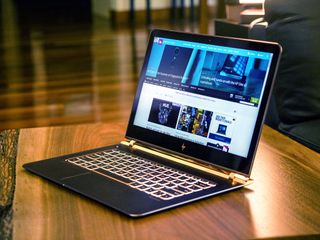
The monthly report from AdDuplex is out for September and with it comes a heaping dose of the obvious and expected. If by magic you were expecting some dramatic shift in mobile or PC usage for Windows 10 despite the lack of anything momentous to catapult it, you will be disappointed.
Nonetheless, let's take a look at what has – and has not – changed since last month.
Anniversary Update for PC is growing, but still just 1/3
The Windows 10 Anniversary Update (1607) is nearing its two-month release and it now accounts for 34.5 percent of all Windows 10 builds on PC. That number is double that from last month where it hovered at 16.2 percent and bodes well for Microsoft.
Even though "only" a third of all Windows 10 PCs are on the Anniversary Update it should be noted that any enterprise usage of Windows 10, which is limited, will be sitting out the upgrade for at least a few months. Companies take a long time to vet OS upgrades and the Anniversary Update is no different.
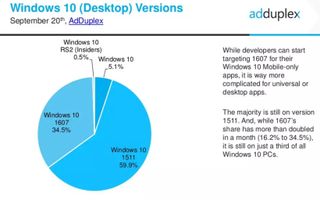
Additionally, Microsoft has stated that it will take at least three months before all users are even offered the upgrade (users can force install it at any time).
The reason for the deliberate throttling is to collect more telemetry from users to ensure the upgrade is going smoothly. Presumably, any issues that are discovered can be mitigated on a smaller scale with the company avoiding any headline-generating problems.
Although the update is going as planned developers still have time to target new features in 1607 for their apps e.g. Hero notifications, chase-able Live Tiles, etc.. That also allows time for Microsoft to address any discrepancies in the SDK and improve developer tools.
Get the Windows Central Newsletter
All the latest news, reviews, and guides for Windows and Xbox diehards.
HP is still king of Windows 10 PCs
Regarding manufacturers, HP is still commanding 22.3 percent of all Windows 10 PCs and laptops. The AdDuplex numbers have not shifted since June with only a few new devices launching over the summer for back-to-school sales.
Behind HP is Dell at 12.2 percent and Lenovo biting at the heels at 11.4 percent. Acer (9.7 percent) and Asus (10.7) are still in the running, but Asus did gain same on the former.
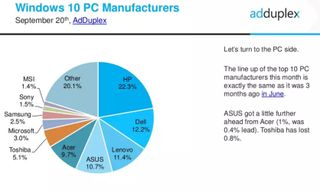
Microsoft and its Surface line are at 3 percent just ahead of Samsung (2.5 percent) who only sell a handful of laptops.
Anniversary Update for Mobile nears 90 percent
Ironically, Microsoft is having greater success in keeping its mobile users on the latest version of the OS. Windows 10 Mobile Anniversary Update is now on 82.4 percent of all Windows 10 Mobile devices even though it launched two weeks later than the one for PC.
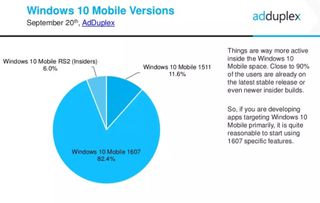
That's a significant bump from 52.4 percent just one month ago, and it demonstrates Microsoft's ability to keep modern devices on the latest version.
Even though carrier approval is still needed for the rarer firmware update (see AT&T who finally released theirs this week) it is clear Microsoft now has the infrastructure to rival Apple for keeping users up to date.
However…
Windows 10 Mobile is still stagnant overall
Bookending the successful upgrade story, however, are two, well-known and sobering facts:
- Windows phone makes a small and increasingly diminishing amount of the entire smartphone market
- Windows 10 Mobile is not even growing within the Windows phone user base
That second point is driven home by the September AdDuplex report that shows only 14 percent of all Windows Phone devices including Windows Phone 7.x, 8.0, and 8.1. That number is completely unchanged from August.
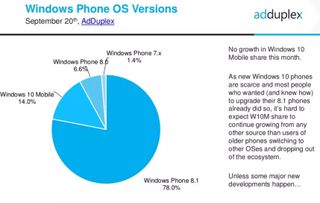
Of course, with the lack of any new hardware and older phones getting cut from retailers none of that is exciting or surprising.
While HP is kind of, almost launching the Elite x3 it is not readily available in consumer channels, and it is not expected to get a bigger push for at least another month. Even then, it will be at least a six to nine-month enterprise adoption period as companies prefer small internal pilot tests to rushed mass deployment.
Alcatel should also be pushing a new VR-themed power housewith the Idol Pro 4. However, any dates and pricing are not known.
Perhaps even more daunting is that nearly 99 percent of all active Windows 10 Mobile phones are Microsoft and Nokia. If Microsoft was hoping for smaller OEMs to step in to make up for their pullback they are failing miserably. Frankly, a lot of that onus is put on those manufacturers who have released less-than-stellar devices. Even the NuAns NEO could not generate enough interest in their failed Kickstarter campaign.
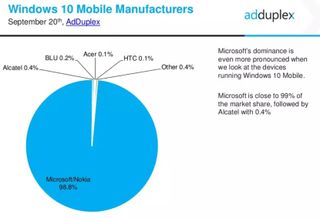
If there is a plan for Windows 10 Mobile, it certainly is not working so far. Microsoft is expected to launch a hero device next year to set the bar, but it remains unclear if they can recreate the same success they have had with Surface and the two-in-one industry (which with gaming is the only growth segment in PCs these days).
The good news in all of this is something I have been saying for a while on the podcast: we are effectively at the bottom regarding smartphone market share. Things can only get better at this point as there is nowhere else to go.
About AdDuplex
The numbers from AdDuplex are collected through their in-app advertising that is prevalent in over 5,000 apps in the Windows Store. That data serves as an important metric within the Windows Phone ecosystem. The full AdDuplex report for September will be posted on their blog at https://blog.adduplex.com/ on Friday (September 23).

Daniel Rubino is the Editor-in-chief of Windows Central. He is also the head reviewer, podcast co-host, and analyst. He has been covering Microsoft since 2007, when this site was called WMExperts (and later Windows Phone Central). His interests include Windows, laptops, next-gen computing, and watches. He has been reviewing laptops since 2015 and is particularly fond of 2-in-1 convertibles, ARM processors, new form factors, and thin-and-light PCs. Before all this tech stuff, he worked on a Ph.D. in linguistics, watched people sleep (for medical purposes!), and ran the projectors at movie theaters because it was fun.
